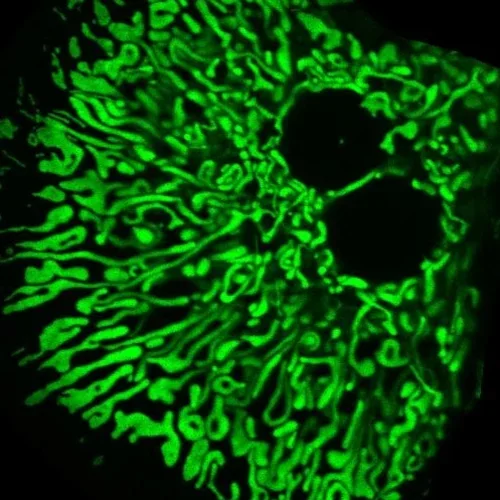Mitochondria and Metabolic Disorders
How do mitochondria affect metabolic disorders?

Marc Liesa-Roig, PhD
Assistant Professor in-Residence
Department of Medicine
Division of Endocrinology
Adaptive and Maladaptive Mitochondrial Changes
Marc Liesa-Roig, PhD, wants to understand how mitochondria adapt and change in metabolic disorders, such as type 2 diabetes and obesity. The team hopes to pinpoint…
Adaptive mitochondrial changes, which may improve metabolic disease outcomes
Maladaptive mitochondria changes, which may worsen metabolic disease outcomes
The team believes defining these changes, and also learning how to balance them, will enable the informed and rational design of metabolic disease therapies.
“ ”
Understanding Mitochondrial Complexities

While attending the University of Barcelona, Liesa-Roig learned that mitochondria have “social networks” and travel around cells, fusing, separating, and even changing shape. Liesa-Roig wondered why mitochondria would need to move and shift. Suspecting this mobility held therapeutic relevance, he decided to dedicate his research to mitochondria.
Liesa-Roig’s studies so far have revealed an array of mitochondrial complexities.
Mitochondria express heterogeneity within the same cell
Along with Orian Shirihai’s team, the Liesa-Roig lab observed that mitochondria, even inside the same cell, can simultaneously perform opposite functions; some mitochondria stimulate fat storage while other mitochondria stimulate fat expenditure.
By highlighting intracellular variations in metabolic regulation, this finding revealed previously unknown layers of metabolic complexity. The collaborators hope understanding the mechanisms of this mitochondrial heterogeneity may uncover new therapeutic targets.
Mitochondria within hepatocytes
Some antioxidants contribute to metabolic disease
Liesa-Roig and his team uncovered a mitochondrial antioxidant system that contributes to metabolic disease. The finding altered the standard assumption that antioxidants, which block oxidative damage in cells, always promote health.
The team successfully found a way to modulate an antioxidant pathway and help obese mice recover normal glycemic function. Now the researchers hope to find a health-optimal balance between adaptive and maladaptive antioxidant mechanisms.
Defining New Metabolic Processes
Liesa-Roig and his team are reconfiguring how we understand metabolic processes, opening new possibilities for treating metabolic diseases and other disorders as well.
Life in the Lab
Liesa-Roig and his team succeed as one of his lab’s core missions. They study both overall mitochondrial physiology as well as specific cellular mechanisms.
Their studies incorporate multiple processes and tissues, including the liver, adipose tissue, and pancreatic beta cells. By defining the mitochondrial mechanisms that affect all these tissues, the team hopes to pinpoint therapies that also span tissues.
Imaging
The team observes mitochondria in real time, as they move and adapt their morphology to differences in the nutrient environment.
Modeling metabolic diseases
The team studies how mitochondria change in obesity and type 2 diabetes, observing outcomes of interventions, which include removing genes that encode for mitochondrial proteins and altering mitochondrial proteins using virus delivery systems.

Michael Shum, PhD
In Liesa-Roig’s lab, Shum studies the role of the mitochondrial protein ATP-binding Cassette B10 (ABCB10) in metabolic diseases and the redox state in liver. He also investigates the interaction between mitochondria and other cellular organelles, such as lipid droplets.
Shum's previous research examined regulatory nodes of signaling pathways that determine insulin resistance in obesity and involve mTORC1,S6K1, RSK, Deptor, insulin receptor, AMPK and angiotensin type 2 receptor in liver, white adipose tissue, and muscle.

Mayuko Segawa, MSc
In Liesa-Roig’s lab, Segawa develops imaging techniques to measure the mitochondrial redox state in pancreatic islets and hepatocytes and conducts high resolution imaging of mitochondria using the Airyscan.
Segawa's previous research focused on the role of YKL-40 in the development of inflammation-associated colonic dysplasia and the role of store-operated channels and PLA2g6 in Ca2+ signaling and ER stress. She also studied the mechanisms of recurrent and/or drug-resistant tumors from Her2-positive breast cancer.

Vincent Gutierrez, student
Vincent is an MD PhD student in the Medical Scientist Training Program (MSTP) program of UCLA DGSOM and Caltech. Before joining UCLA, Vincent performed undergraduate research at Boston University and at the NIH.